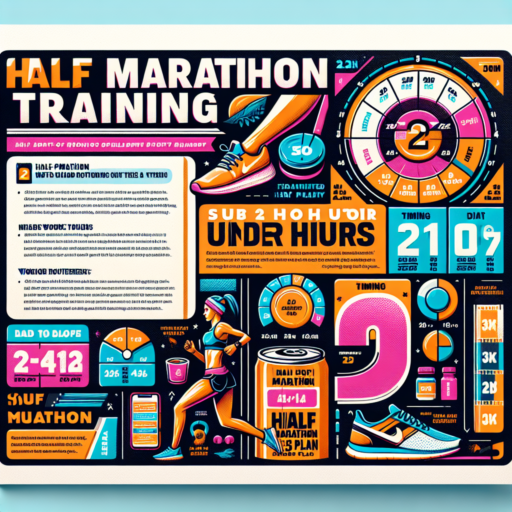How to train to run a sub-5 hour marathon?
Preparing for a marathon with a goal of completing it in less than 5 hours is a significant commitment that demands a strategic and disciplined approach to training. A sub-5 hour marathon means maintaining a pace slightly over 11 minutes per mile. To achieve this, it’s not only about increasing your miles significantly but also about incorporating a variety of workouts that enhance both your speed and endurance.
Key Components of an Effective Marathon Training Plan
- Long Runs: Gradually increase the length of your long runs each week. These runs are critical for building endurance and teaching your body to burn fat efficiently alongside glycogen.
- Speed Work: Incorporate intervals and tempo runs into your training. Speed work improves your aerobic capacity and helps you maintain a faster pace for longer periods.
- Rest and Recovery: It’s essential to respect the importance of rest and recovery days. Overtraining can lead to injuries, which can derail your training plan.
In addition to these workouts, focus on maintaining a well-balanced diet to fuel your body with the necessary nutrients for recovery and energy. Hydration and sleep are equally crucial in keeping your body in top shape for the challenges of marathon training. Remember, consistency is key to successful marathon preparation. Failure to adhere to a comprehensive plan could result in falling short of your sub-5 hour marathon goal.
No se han encontrado productos.
What pace is a sub 5 hour marathon?
To achieve a sub 5 hour marathon, understanding the necessary pace is crucial. In basic terms, to finish a 26.2-mile marathon in less than five hours, runners need to maintain an average pace. This requires strategic pacing and consistent effort throughout the race.
Achieving the Target Pace
To complete a marathon in under 5 hours, an average pace of approximately 11:27 minutes per mile (or 7:07 minutes per kilometer) is required. This pace must be maintained consistently across all 26.2 miles to ensure finishing under the target time. It’s a pace that necessitates a solid base of endurance training, as it challenges the runner to maintain a steady but manageable speed over an extended period.
Strategies for Maintaining Pace
- Starting Slow: Begin the marathon slightly slower than your target pace to conserve energy.
- Middle Miles: Gradually increase your speed to hit the target pace, focusing on consistency.
- Final Stretch: Assess your energy levels and push harder if feasible, to compensate for any earlier slowdowns.
Achieving a sub 5 hour marathon is about precision and pacing. As runners aim for this goal, focusing on maintaining an even pace throughout can make a significant difference in their final time.
How to run a marathon in under 5 hours?
Running a marathon in under 5 hours is a common goal for many beginner to intermediate runners. This ambitious yet achievable target requires a blend of consistent training, strategic planning, and nutritional discipline. By adhering to a well-structured training plan and incorporating some essential strategies, breaking the 5-hour barrier is definitely within reach.
Training Plan and Mileage
Success in marathon running, especially with a time goal in mind, hinges largely on following a dedicated training plan. It’s crucial to gradually increase your weekly mileage with a mix of long runs, tempo runs, and speedwork sessions. A balanced approach ensures that you enhance your aerobic capacity, improve your running economy, and build the necessary endurance. Remember, the key is consistency; missing too many training runs can significantly impact your race day performance.
Pacing Strategy
Developing and executing a smart pacing strategy is vital. Aim to start the marathon at a pace that feels almost too easy. This conservative approach pays off by conserving energy for the latter half of the race, helping to prevent hitting the dreaded «wall.» Utilize pace bands or a GPS watch to keep yourself in check during the race. Remember, the goal is to split your marathon (running the second half as fast as or faster than the first half), a technique known as negative splitting.
Nutrition and Hydration
Optimizing your nutrition and hydration strategy both during training and on race day can significantly affect your marathon finish time. Focus on a diet rich in complex carbohydrates, lean proteins, and healthy fats to fuel your runs. During long training runs, practice your hydration and carbohydrate intake to discover what works best for you. Come race day, stick with familiar foods and drinks to avoid any gastrointestinal distress.
How do you fuel a 5 hour marathon?
Fueling for a 5-hour marathon requires a careful and strategic approach to ensure that you maintain energy levels, hydrate adequately, and avoid gastrointestinal discomfort. The foundation of marathon fueling is built on carbohydrate loading, as carbs provide the most efficient form of energy for endurance athletes.
Carbohydrate Loading: Begin carb-loading about 3 days before your marathon. This doesn’t mean eating an excessive amount of food but rather shifting the percentage of your calories to come primarily from carbohydrates. Foods like pasta, rice, bread, and potatoes are excellent sources. It’s also crucial during this period to stay hydrated and to slightly increase salt intake to store additional water.
During the Marathon: Hydration is key, especially for a marathon that might span over 5 hours. Drinking water with electrolytes is essential to prevent dehydration and maintain electrolyte balance. For your energy needs, consume easily digestible carbs every 30-45 minutes. This can be in the form of gels, chews, or even sports drinks. It’s advisable to start this early in the race to prevent hitting the proverbial ‘wall’.
Remember, the specifics of fueling can vary based on individual tolerance, weather conditions, and personal preferences. Testing your fueling strategy during long training runs will help you refine it for race day, ensuring that your performance is optimized for a 5-hour marathon.



